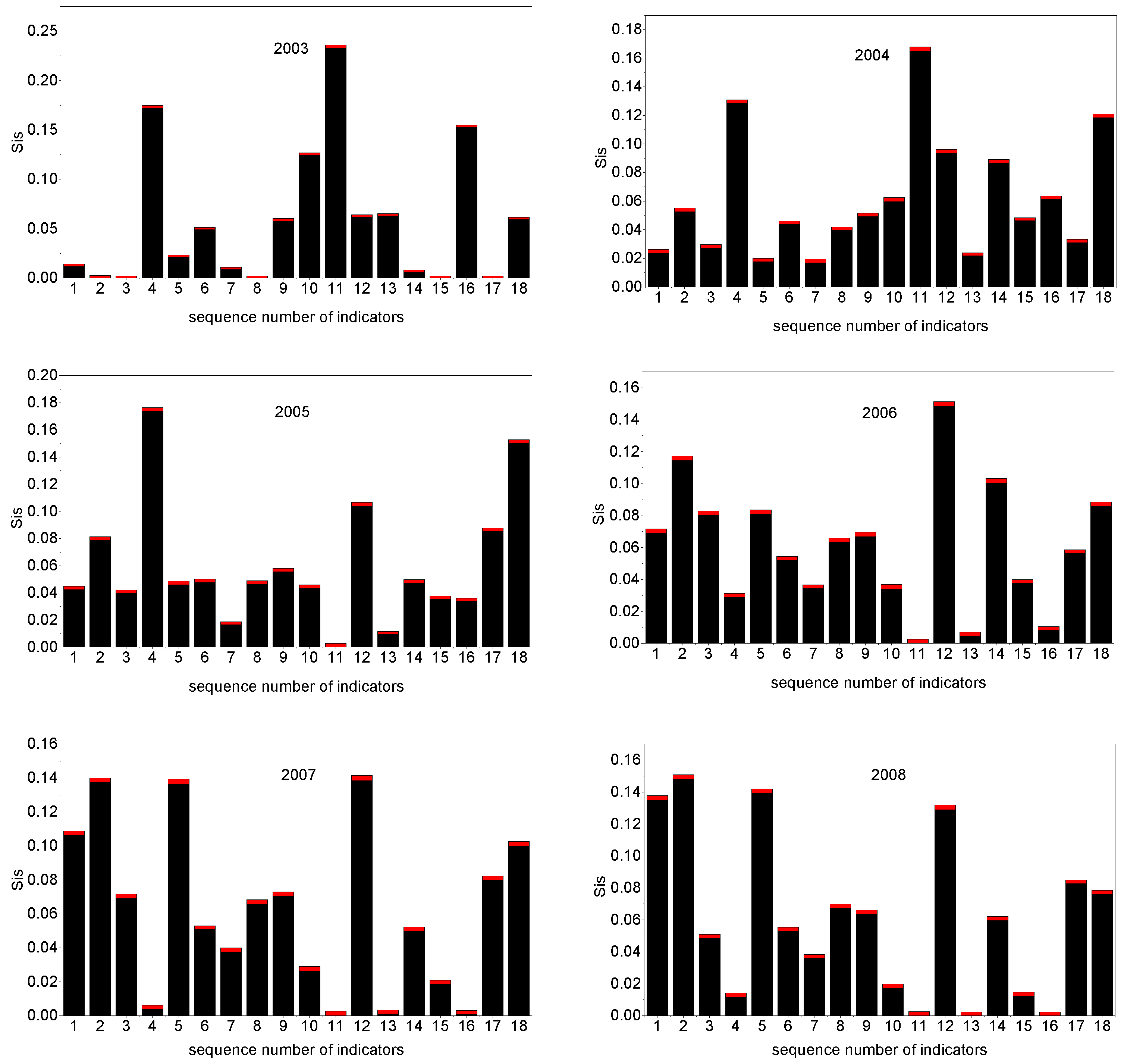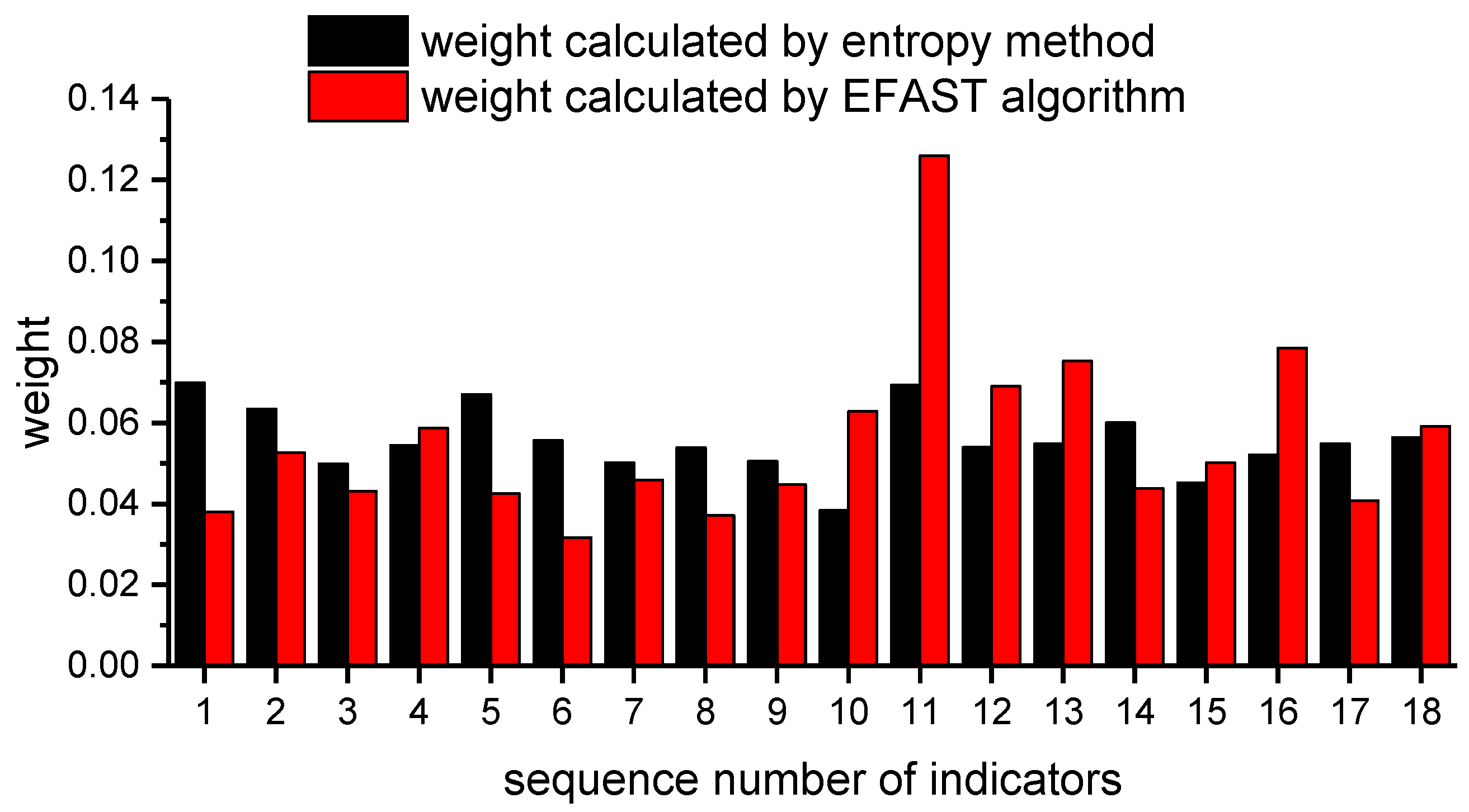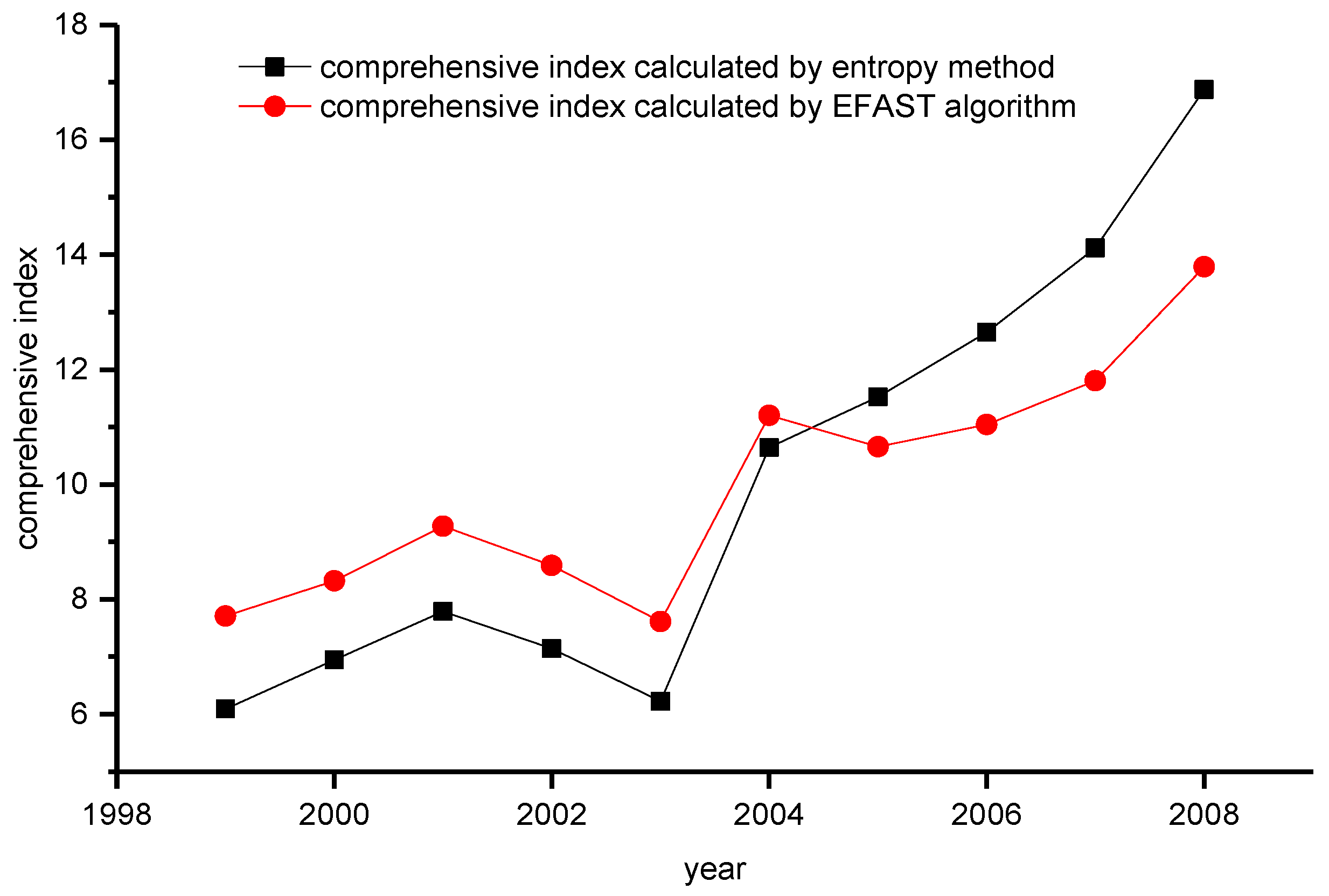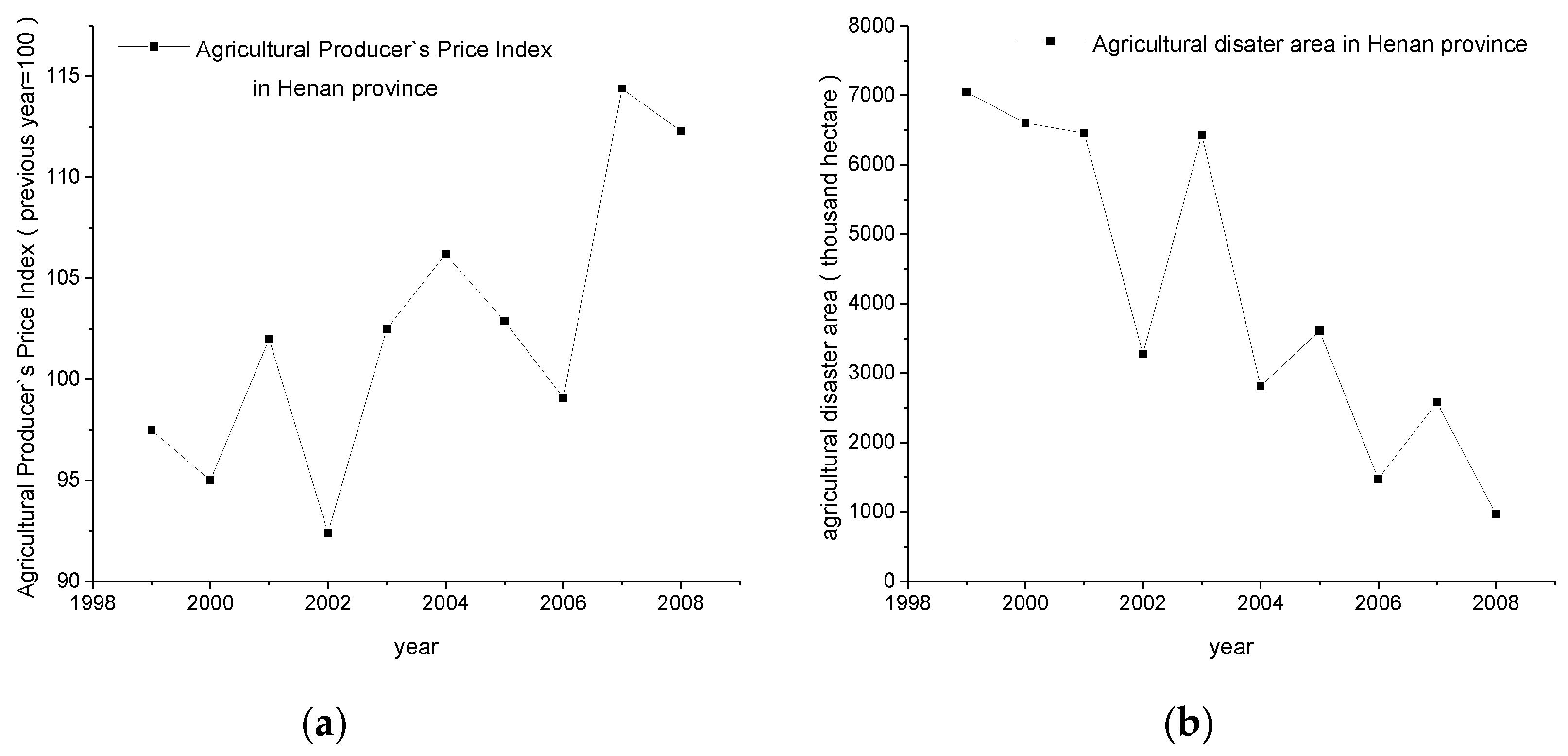Weight Determination of Sustainable Development Indicators Using a Global Sensitivity Analysis Method
Abstract
:1. Introduction
2. Materials and Methods
2.1. Overview of the Indicator System
2.2. Data
2.3. Model
2.4. Weight Determination Methods
2.4.1. EFAST Algorithm and Its Implementation in Indicator Weighing
2.4.2. Entropy Method on Weight Determination
2.4.3. Brief Comparison of the EFAST Method and Entropy Method
3. Results
3.1. Sensitive Analysis of Indicators in Different Stages
3.2. Analysis of the Weights Determined by the EFAST Algorithm
4. Discussion
4.1. Comparison of the Weights Determined by the EFAST Algorithm and Entropy Method
4.2. Comparison and Analysis of the Evaluation Results Produced by the EFAST and Entropy Methods
5. Conclusions
Acknowledgments
Author Contributions
Conflicts of Interest
References
- Lombardi, P.; Brandon, P.S. Evaluating sustainable development in the built environment. Environ. Plan. C Gov. Policy 2005, 24, 473–474. [Google Scholar]
- Andriantiatsaholiniaina, L.A.; Kouikoglou, V.S.; Phillis, Y.A. Evaluating strategies for sustainable development: Fuzzy logic reasoning and sensitivity analysis. Ecol. Econ. 2004, 48, 149–172. [Google Scholar] [CrossRef]
- Moran, D.D.; Wackernagel, M.; Kitzes, J.A.; Goldfinger, S.H.; Boutaud, A. Measuring sustainable development — nation by nation. Ecol. Econ. 2008, 64, 470–474. [Google Scholar] [CrossRef]
- Si, H.; Bi, H.; Li, X.; Yang, C. Environmental evaluation for sustainable development of coal mining in qijiang, western china. Int. J. Coal Geol. 2010, 81, 163–168. [Google Scholar] [CrossRef]
- Karger, C.R.; Hennings, W. Sustainability evaluation of decentralized electricity generation. Renew. Sustain. Energy Rev. 2009, 13, 583–593. [Google Scholar] [CrossRef]
- Qiao, J.J. Application of improved entropy method in henan sustainable development evaluation. Resource. Science. 2004, 26, 113–119. [Google Scholar]
- Diakoulaki, D.; Mavrotas, G.; Papayannakis, L. Determining objective weights in multiple criteria problems: The critic method. Comput. Oper. Res. 1995, 22, 763–770. [Google Scholar] [CrossRef]
- Decancq, K.; Lugo, M.A. Weights in multidimensional indices of wellbeing: An overview. Econ. Rev. 2013, 32, 7–34. [Google Scholar] [CrossRef]
- Singh, R.K.; Murty, H.R.; Gupta, S.K.; Dikshit, A.K. Development of composite sustainability performance index for steel industry. Ecol. Indic. 2007, 7, 565–588. [Google Scholar] [CrossRef]
- Ma, J.; Fan, Z.-P.; Huang, L.-H. A subjective and objective integrated approach to determine attribute weights. Eur. J. Oper. Res. 1999, 112, 397–404. [Google Scholar] [CrossRef]
- Wang, T.-C.; Lee, H.-D. Developing a fuzzy topsis approach based on subjective weights and objective weights. Expert Syst. Appl. 2009, 36, 8980–8985. [Google Scholar] [CrossRef]
- Rao, R.V.; Patel, B.K. A subjective and objective integrated multiple attribute decision making method for material selection. Mater. Des. 2010, 31, 4738–4747. [Google Scholar] [CrossRef]
- Saltelli, A.; Tarantola, S.; Chan, K.P.S. A quantitative model-independent method for global sensitivity analysis of model output. Technometrics 1999, 41, 39–56. [Google Scholar] [CrossRef]
- Palme, U.; Tillman, A.-M. Sustainable development indicators: How are they used in swedish water utilities? J. Clean. Prod. 2008, 16, 1346–1357. [Google Scholar] [CrossRef]
- Hardi, P. Measuring performance in sustainable development. Int. Conf. Environ. Pollut. Proc. 1996, 1–2, 70–76. [Google Scholar]
- UNDP. Transforming Our World: The 2030 Agenda for Sustainable Development. Available online: https://sustainabledevelopment.un.org/post2015/transformingourworld/ (accessed on 25 September 2015).
- Mei, F.Q. China's Agricultural Sustainable Development and Comprehensive Productivity Research; Shandong Technology Press: Shandong, China, 1995. [Google Scholar]
- Joung, C.B.; Carrell, J.; Sarkar, P.; Feng, S.C. Categorization of indicators for sustainable manufacturing. Ecol. Indic. 2013, 24, 148–157. [Google Scholar] [CrossRef]
- Xin, L.; Hu, Z.Q. Evaluation of agriculture sustainable development level in China. J. Agr. Sci. Tech. (Beijing). 2015, 17, 135–142. [Google Scholar]
- Stöglehner, G. Ecological footprint—A tool for assessing sustainable energy supplies. J. Clean. Prod. 2003, 11, 267–277. [Google Scholar] [CrossRef]
- Cooper, W.W.; Seiford, L.M.; Zhu, J. (Eds.) Data envelopment analysis. In Handbook on Data Envelopment Analysis; Springer: Boston, MA, USA, 2004; pp. 1–39.
- Spieksma, F.C.R. Multi index assignment problems: Complexity, approximation, applications. In Nonlinear Assignment Problems: Algorithms and Applications; Pardalos, P.M., Pitsoulis, L.S., Eds.; Springer: Boston, MA, USA, 2000; pp. 1–12. [Google Scholar]
- Sobol, I.M. Sensitivity estimates for nonlinear mathematical model. Math. Model. Comput. Exp. 1993, 1, 407–414. [Google Scholar]
- Ma, C.F.; Li, X.; Wang, S.G. A global sensitivity analysis of soil parameters associated with backscattering using the advanced integral equation model. IEEE Trans. Geosci. Remote Sens. 2015, 53, 5613–5623. [Google Scholar]
- Morris, D.J.; Speirs, D.C.; Cameron, A.I.; Heath, M.R. Global sensitivity analysis of an end-to-end marine ecosystem model of the north sea: Factors affecting the biomass of fish and benthos. Ecol. Model. 2014, 273, 251–263. [Google Scholar] [CrossRef] [Green Version]
- Cvetkovic, V.; Soltani, S.; Vigouroux, G. Global sensitivity analysis of groundwater transport. J. Hydrol. 2015, 531, 142–148. [Google Scholar] [CrossRef]
- Wang, J.; Li, X.; Lu, L.; Fang, F. Parameter sensitivity analysis of crop growth models based on the extended fourier amplitude sensitivity test method. Environ. Model. Softw. 2013, 48, 171–182. [Google Scholar] [CrossRef]
- Gan, Y.; Duan, Q.; Gong, W.; Tong, C.; Sun, Y.; Chu, W.; Ye, A.; Miao, C.; Di, Z. A comprehensive evaluation of various sensitivity analysis methods: A case study with a hydrological model. Environ. Model. Softw. 2014, 51, 269–285. [Google Scholar] [CrossRef]
- Simlab. Simulation Laboratory for Uncertainty and Sensitivity Analysis. Available online: http://simlab.jrc.ec.europa.eu (18 February 2017).
- Bhatta, B.; Saraswati, S.; Bandyopadhyay, D. Quantifying the degree-of-freedom, degree-of-sprawl, and degree-of-goodness of urban growth from remote sensing data. Appl. Geogr. 2010, 30, 96–111. [Google Scholar] [CrossRef]
- Xianguang, G. Application of improved entropy method in evaluation of economic result. Syst. Eng.-Theory Pract. 1998, 18, 98–102. [Google Scholar]
- Zou, Z.-H.; Yi, Y.; Sun, J.-N. Entropy method for determination of weight of evaluating indicators in fuzzy synthetic evaluation for water quality assessment. J. Environ. Sci. 2006, 18, 1020–1023. [Google Scholar] [CrossRef]





| Number | Index | Computing Method |
|---|---|---|
| 1 | Net income per capita of farmers (yuan) | Net income of rural households/rural households resident population |
| 2 | Arable land output level (yuan/hm2) | Agricultural output/arable land |
| 3 | Grain share per capita (kg/person) | Food production/total population |
| 4 | Meat share per capita (kg/person) | Meat production/total population |
| 5 | Fish consumption per capita (kg/person) | Aquatic products/total population |
| 6 | Mechanical effective utilization factor (kw/hm2) | Mechanical power/arable land |
| 7 | Effective irrigation coefficient (%) | Effective irrigation area/arable land |
| 8 | Chemical fertilizer-dependent output assuming 100% utilization (yuan/hm2) | Agricultural output/consumption of chemical fertilizer by 100% effective component |
| 9 | Multiple cropping index (%) | Crop acreage/arable land |
| 10 | Arable land per capita (hm2/person) | Cultivated area/total population |
| 11 | Forest coverage (%) | Forest area/total land area |
| 12 | Improvement rate of soil and water loss (%) | Soil and water loss improvement area/soil and water loss area |
| 13 | Chemical fertilizer application rate assuming 100% utilization(kg/hm2) | Consumption of chemical fertilizer by 100% effective component/crop acreage |
| 14 | Agricultural disaster area (1000 hm2) | Directly from Henan Statistical Yearbook |
| 15 | Pesticide use intensity (kg/hm2) | Pesticide amount/crop acreage |
| 16 | Plastic sheeting use (kg/hm2) | Plastic sheeting/crop acreage |
| 17 | Agricultural energy consumption index (t/104 yuan) | Agriculture, forestry, animal husbandry and fishery energy consumption/agricultural output |
| 18 | Water use per 104 yuan of agricultural output (m3/104·yuan) | Agricultural water/agricultural output |
| Index | 1999 | 2000 | 2001 | 2002 | 2003 | 2004 | 2005 | 2006 | 2007 | 2008 |
|---|---|---|---|---|---|---|---|---|---|---|
| Net income per capita of farmers (yuan) | 1949 | 1986 | 2098 | 2216 | 2236 | 2553 | 2871 | 3261 | 3852 | 4454 |
| Arable land output level (yuan/hm2) | 18,047.4 | 18,389.1 | 19,278.1 | 16,731.8 | 15,829.5 | 22,332.2 | 24,862.5 | 27,922.6 | 31,304.2 | 35559.97 |
| Grain share per capita (kg/person) | 453.10 | 432.28 | 431.18 | 437.95 | 369.24 | 438.41 | 469.08 | 520.60 | 531.48 | 540.98 |
| Meat share per capita (kg/person) | 51.68 | 54.49 | 56.58 | 59.30 | 62.43 | 66.17 | 70.54 | 59.53 | 55.01 | 58.93 |
| Fish consumption per capita (kg/person) | 3.07 | 3.39 | 3.29 | 3.77 | 4.03 | 4.39 | 5.29 | 6.26 | 7.57 | 8.64 |
| Mechanical effective utilization factor (kw/hm2) | 7.83 | 8.41 | 8.80 | 9.02 | 9.67 | 10.48 | 11.02 | 11.54 | 12.11 | 13.09 |
| Effective irrigation coefficient (%) | 68.10 | 68.70 | 69.00 | 66.10 | 66.70 | 67.30 | 67.50 | 68.30 | 68.80 | 69.30 |
| Chemical fertilizer-dependent output assuming 100% utilization (yuan/hm2) | 30.81 | 30.05 | 30.15 | 25.92 | 24.32 | 32.50 | 34.55 | 37.21 | 39.57 | 42.57 |
| Multiple cropping index (%) | 185.47 | 191.08 | 190.16 | 183.95 | 190.39 | 192.35 | 193.34 | 194.31 | 195.62 | 196.94 |
| Arable land per capita (hm2/person) | 0.07 | 0.07 | 0.07 | 0.08 | 0.07 | 0.07 | 0.07 | 0.07 | 0.07 | 0.07 |
| Forest coverage (%) | 19.80 | 19.80 | 19.80 | 19.80 | 19.80 | 19.80 | 16.20 | 16.20 | 16.20 | 16.20 |
| Improvement rate of soil and water loss (%) | 61.70 | 62.70 | 63.80 | 64.70 | 65.40 | 66.50 | 67.60 | 68.50 | 69.40 | 71.10 |
| Chemical fertilizer application rate assuming 100% utilization(kg/hm2) | 585.80 | 611.92 | 441.73 | 468.83 | 651.00 | 687.00 | 720.00 | 750.00 | 791.00 | 835.00 |
| Agricultural disaster area (1000 hm2) | 7049.30 | 6604.60 | 6458.40 | 3278.30 | 6433.80 | 2807.40 | 3609.80 | 1474.79 | 2577.68 | 967.00 |
| Pesticide use intensity (kg/hm2) | 20.41 | 21.03 | 21.10 | 21.74 | 24.68 | 21.31 | 20.99 | 20.64 | 21.30 | 21.31 |
| Plastic sheeting use (kg/hm2) | 11.63 | 13.37 | 13.62 | 13.58 | 13.75 | 14.16 | 15.05 | 16.44 | 17.58 | 18.15 |
| Agricultural energy consumption index | 2.80 | 2.92 | 2.89 | 2.99 | 3.17 | 2.79 | 2.40 | 2.48 | 2.25 | 2.02 |
| (t/104 yuan) | 1295.07 | 1061.46 | 1198.78 | 1199.31 | 996.31 | 776.97 | 640.02 | 696.88 | 532.58 | 521.22 |
© 2017 by the authors. Licensee MDPI, Basel, Switzerland. This article is an open access article distributed under the terms and conditions of the Creative Commons Attribution (CC BY) license ( http://creativecommons.org/licenses/by/4.0/).
Share and Cite
Luan, W.; Lu, L.; Li, X.; Ma, C. Weight Determination of Sustainable Development Indicators Using a Global Sensitivity Analysis Method. Sustainability 2017, 9, 303. https://doi.org/10.3390/su9020303
Luan W, Lu L, Li X, Ma C. Weight Determination of Sustainable Development Indicators Using a Global Sensitivity Analysis Method. Sustainability. 2017; 9(2):303. https://doi.org/10.3390/su9020303
Chicago/Turabian StyleLuan, Wenfei, Ling Lu, Xin Li, and Chunfeng Ma. 2017. "Weight Determination of Sustainable Development Indicators Using a Global Sensitivity Analysis Method" Sustainability 9, no. 2: 303. https://doi.org/10.3390/su9020303






